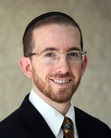Natan Slifkin's Blog, page 167
August 17, 2013
Baruch Dayan Ha-Emet
With great sadness, I am reporting the tragic passing of my beloved mother-in-law, Mrs. Anne Samson, who was killed in a car accident on Friday. My father-in-law will hopefully be released from hospital tomorrow. Hespedim will be delivered at Beth Jacob tomorrow morning at 9am. The funeral will take place in Israel on Monday and shivah will take place in Ramat Bet Shemesh and in Los Angeles.
(Your good wishes are appreciated, but if possible, please refrain from submitting comments or sending emails at this time.)
(Your good wishes are appreciated, but if possible, please refrain from submitting comments or sending emails at this time.)
Published on August 17, 2013 22:05
August 12, 2013
What Are Those Quoters Thinking?
(Note: This post is a mirror-image of an article published by Eytan Kobre in Mishpachah magazine. You have to read the original article in order to understand the tone of this post.)
One fascinating aspect of the writings of Rav Yosef Eliyahu Henkin ztz”l is that he published many essays addressing political and social issues of the day, setting forth a clear Torah hashkafah on how to relate to such phenomena as the State of Israel, anti-Semitism, the secular American Jewish establishment, and postwar Germany. He based his views on these, and many more matters, on an extremely wide range of sources, including episodes in Tanach and later Jewish history, on the statements of Chazal in Shas and midrashim, and of gedolei Torah he had known.
Looking at Rav Henkin’s deeply sourced and compellingly argued essays, one can’t help but contrast them with, l’havdil, what often passes for Torah-based arguments in contemporary discourse.
In the recent controversy over the draft of bnei Torah, for example, one comes across articles in which the same handful of sources are recycled endlessly to support the innovation of mass kollel. There’s the Mishnaic dictum of Talmud Torah kenegged kulam, and that hardy perennial, the Rambam (Hilchos Shmittah V'Yovel), who writes that anyone can choose the life of a Levite.
One must really wonder what people who quote these sources as discussion-enders are thinking. If one has a question about how to reconcile a mishnah with the practice of multitudes of very observant Jews for centuries, then by all means pose it, earnestly and humbly, and seek out an answer. But these sources are cited triumphantly as conclusory evidence against the position of Chazal, the Rishonim, and the greatest halachic authorities right up until the charedi rabbonim post-WWII, who not only permitted but highly encouraged people to learn a trade and work for a living.
It’s impossible to even imagine another field of highly complex knowledge in which those defending a revolutionary approach would be so foolish and so lacking in humility as to pronounce every acknowledged traditional master of the discipline mistaken for having missed a basic piece of information. But let the conversation turn to something Torah-related, and it’s the Wild West, with every man and his Judaic six-shooter for himself.
Rabbi Aryeh Zev Ginsberg recently wrote of having accompanied Rav Elyashiv ztz”l to and from a funeral, with pen and pad in hand to record the various questions people would inevitably ask. In the course of this 40-minute experience, Rav Elyashiv answered more than 70 sh’eilos, exhibiting his breathtaking mastery of the gamut of Torah. And Rav Elyashiv strongly supported mass kollel. Yet we are to believe, it seems, that this somehow radically alters the very history of our people and the very statements of Chazal and the Rishonim. Don’t those who fling the Gedolim as a shtempel kashrus know that there are Gedolim who disagree strongly with the modern system of mass kollel, but who are afraid to speak their mind, as Jonathan Rosenblum has written? Do they not know that there are complex social forces mean that attitudes to basic issues can change and be distorted, even amongst great Torah scholars? Do they not know the history of the Jewish People, in which many great Torah scholars were embroiled in disputes in which they each considered their equally distinguished opponents to be fundamentally in error? That they attributed such fundamental error to the ability of sophisticated Torah learning to resolve all contradictions between behavior and sources via the drawing of subtle distinctions? This is precisely why halachic practice has always been rooted in the values and rulings of Shas and Rishonim, not in contemporary mores that go against mesorah.
Let’s look, for example, at Eytan Kobre. In an article printed in the latest issue of Mishpachah, Mr. Kobre claims "the Kesef Mishneh, on the page alongside the Rambam; the Rema (Yoreh Dei’ah 246:21); the Shach (ibid.); the Aruch HaShulchan (Yoreh Dei’ah 246:40-42); and Igros Moshe (Yoreh Dei’ah 2:116) all rule that one may, without any hesitation, receive funding to learn Torah full-time."
Now, Eytan Kobre is being presented as the Voice of Torah Judaism. He is, after all, someone who studied for several years in beis medrash and beyond, and presumably knows how to research a basic halachic issue. Here, then, is what he could have discovered if he had actually looked at the very sources that he himself is quoting, let alone the countless sources in Chazal and the Rishonim that strongly oppose the notion of not learning a trade or working and instead relying on communal support:
The Kesef Mishneh indeed observed that Rambam's prohibition on Torah scholars receiving payment was not shared by other authorities, and permits a Torah scholar to receive funds. However, he specifies that this is only in a case where he is teaching students, acting as a rabbinic judge, or studying in order to take on a teaching/judging role (although elsewhere he appears to be more lenient). How on earth does Mr. Kobre describe this as him saying that "one may, without any hesitation, receive funding to learn Torah full-time"?
The Rema first says that a person should work to support himself, leaving Torah study to other times of day and night, and that it is very praiseworthy to be self-sufficient. Which is not at all surprising, since Chazal taught that Torah study should be accompanied by derech eretz, and in numerous places stressed the importance of being self-sufficient: “A person should hire himself out for alien work rather than requiring assistance from others”; “The man who is self-sufficient is greater than the one who fears Heaven”; etc. The Rema continues to note that someone who decides to busy themselves with Torah and live off charity rather than working has desecrated God's Name and brought the Torah into disrepute. He adds that Torah which is not accompanied by work leads to sin and theft (presumably because the Torah scholar/student is incapable of making a living via honest means). Similarly, the Rosh, discussing someone whose Torah is his profession, such that he is exempt from paying various taxes, defines this person as someone who only takes time away from his studies in order to earn a livelihood, “which is his obligation, for the study of Torah with derech eretz is beautiful, and if the Torah is not accompanied by work, it will end in neglect and will cause sin." This reflects the normative position amongst the Rishonim in Ashkenaz, where financing Torah study was unheard of; virtually all Torah scholars were self-supporting, and even financing Torah teaching was only reluctantly permitted by some.
So far, Rema has been unequivocal that it is forbidden and evil to take money for Torah rather than to be self-supportive (except for those who are physically incapable of working, and who are allowed to receive payment for the Torah that they teach.) But at this point he introduces a lenient view, based on R. Shimon b. Tzemach Duran (Rashbatz), that permits Torah scholars to receive funding. Note, however, that Rashbatz specifically limits this to Torah scholars functioning in the role of community rabbi. In the referenced responsum, he argues that since the Kohen Gadol receives material support from the community, how much more so should a Torah scholar be entitled to such support; after all, he is equally performing a service for the community. Rema writes that “a person important to the community may accept money from it... without violating the prohibition against benefiting from the Torah, for he is honoring the Torah, not using it." He is not talking about a kollel student!
However, Rema proceeds to note that there are those who are even more lenient and permit even students to receive financial support, in order to strengthen Torah study. So there we have it; after stating the primary view, that it is forbidden and wrong for Torah scholars to receive funding, then noting a "yesh omrim," an alternate lenient view that it is permissible for rabbis to receive funding, we finally have a further lenient view that even students may receive funding. However, Rema notes that it is still preferable for Torah students to be self-supportive, if possible. How on earth does Mr. Kobre summarize all this as him saying that "one may, without any hesitation, receive funding to learn Torah full-time"?
Now let us move on to the next source cited by Mr. Kobre, the Shach. He allows a Rosh Yeshivah or Av Beis Din to accept gifts. He says nothing whatsoever about kollel students receiving funding to learn Torah. How on earth does Mr. Kobre summarize all this as saying that "one may, without any hesitation, receive funding to learn Torah full-time"?
Now let us move on to the next source cited by Mr. Kobre, the Aruch HaShulchan. He, too, makes it very clear that he is talking about voluntary communal support of Torah teachers. He does not permit Torah students to receive communal funds, and does not even permit teachers to demand support; he describes Rambam's opposition as being to Torah scholars who try to force the community to support them (an apt description of the modern mass-kollel system). How on earth does Mr. Kobre summarize all this as saying that "one may, without any hesitation, receive funding to learn Torah full-time"?
Igros Moshe is Mr. Kobre's final source for those who wish to receive money for their studies. However, that has little bearing on the normative position over the ages. R. Moshe's primary sources are referring to Torah teachers, not Torah students. And he admits that his license may well be based upon emergency measures, rather than expressing the original laws and priorities. And one cannot necessarily extrapolate from the state of Torah-emergency in 1964 to the situation in the twenty-first century, when there are tens of thousands of people in kollel. Furthermore, Rav Moshe is only addressing a case where the money is being offered - this has nothing to do with whether it is okay to avoid learning a trade and to insist that others support you. Which clearly goes against Chazal and the Rishonim.
Can this fellow Eytan Kobre truly be blissfully unaware of all this, and of the normative approach of Torah Judaism throughout the ages until just a few decades ago, or is he indeed aware of the relevant halachic sources and is engaging in intentional falsification of Torah to mislead the public? Either way, hostile or ignorant, it doesn’t bode well.
(If you are reading this post by email, please continue to scroll down, in order to see the previous post on hawking.)
One fascinating aspect of the writings of Rav Yosef Eliyahu Henkin ztz”l is that he published many essays addressing political and social issues of the day, setting forth a clear Torah hashkafah on how to relate to such phenomena as the State of Israel, anti-Semitism, the secular American Jewish establishment, and postwar Germany. He based his views on these, and many more matters, on an extremely wide range of sources, including episodes in Tanach and later Jewish history, on the statements of Chazal in Shas and midrashim, and of gedolei Torah he had known.
Looking at Rav Henkin’s deeply sourced and compellingly argued essays, one can’t help but contrast them with, l’havdil, what often passes for Torah-based arguments in contemporary discourse.
In the recent controversy over the draft of bnei Torah, for example, one comes across articles in which the same handful of sources are recycled endlessly to support the innovation of mass kollel. There’s the Mishnaic dictum of Talmud Torah kenegged kulam, and that hardy perennial, the Rambam (Hilchos Shmittah V'Yovel), who writes that anyone can choose the life of a Levite.
One must really wonder what people who quote these sources as discussion-enders are thinking. If one has a question about how to reconcile a mishnah with the practice of multitudes of very observant Jews for centuries, then by all means pose it, earnestly and humbly, and seek out an answer. But these sources are cited triumphantly as conclusory evidence against the position of Chazal, the Rishonim, and the greatest halachic authorities right up until the charedi rabbonim post-WWII, who not only permitted but highly encouraged people to learn a trade and work for a living.
It’s impossible to even imagine another field of highly complex knowledge in which those defending a revolutionary approach would be so foolish and so lacking in humility as to pronounce every acknowledged traditional master of the discipline mistaken for having missed a basic piece of information. But let the conversation turn to something Torah-related, and it’s the Wild West, with every man and his Judaic six-shooter for himself.
Rabbi Aryeh Zev Ginsberg recently wrote of having accompanied Rav Elyashiv ztz”l to and from a funeral, with pen and pad in hand to record the various questions people would inevitably ask. In the course of this 40-minute experience, Rav Elyashiv answered more than 70 sh’eilos, exhibiting his breathtaking mastery of the gamut of Torah. And Rav Elyashiv strongly supported mass kollel. Yet we are to believe, it seems, that this somehow radically alters the very history of our people and the very statements of Chazal and the Rishonim. Don’t those who fling the Gedolim as a shtempel kashrus know that there are Gedolim who disagree strongly with the modern system of mass kollel, but who are afraid to speak their mind, as Jonathan Rosenblum has written? Do they not know that there are complex social forces mean that attitudes to basic issues can change and be distorted, even amongst great Torah scholars? Do they not know the history of the Jewish People, in which many great Torah scholars were embroiled in disputes in which they each considered their equally distinguished opponents to be fundamentally in error? That they attributed such fundamental error to the ability of sophisticated Torah learning to resolve all contradictions between behavior and sources via the drawing of subtle distinctions? This is precisely why halachic practice has always been rooted in the values and rulings of Shas and Rishonim, not in contemporary mores that go against mesorah.
Let’s look, for example, at Eytan Kobre. In an article printed in the latest issue of Mishpachah, Mr. Kobre claims "the Kesef Mishneh, on the page alongside the Rambam; the Rema (Yoreh Dei’ah 246:21); the Shach (ibid.); the Aruch HaShulchan (Yoreh Dei’ah 246:40-42); and Igros Moshe (Yoreh Dei’ah 2:116) all rule that one may, without any hesitation, receive funding to learn Torah full-time."
Now, Eytan Kobre is being presented as the Voice of Torah Judaism. He is, after all, someone who studied for several years in beis medrash and beyond, and presumably knows how to research a basic halachic issue. Here, then, is what he could have discovered if he had actually looked at the very sources that he himself is quoting, let alone the countless sources in Chazal and the Rishonim that strongly oppose the notion of not learning a trade or working and instead relying on communal support:
The Kesef Mishneh indeed observed that Rambam's prohibition on Torah scholars receiving payment was not shared by other authorities, and permits a Torah scholar to receive funds. However, he specifies that this is only in a case where he is teaching students, acting as a rabbinic judge, or studying in order to take on a teaching/judging role (although elsewhere he appears to be more lenient). How on earth does Mr. Kobre describe this as him saying that "one may, without any hesitation, receive funding to learn Torah full-time"?
The Rema first says that a person should work to support himself, leaving Torah study to other times of day and night, and that it is very praiseworthy to be self-sufficient. Which is not at all surprising, since Chazal taught that Torah study should be accompanied by derech eretz, and in numerous places stressed the importance of being self-sufficient: “A person should hire himself out for alien work rather than requiring assistance from others”; “The man who is self-sufficient is greater than the one who fears Heaven”; etc. The Rema continues to note that someone who decides to busy themselves with Torah and live off charity rather than working has desecrated God's Name and brought the Torah into disrepute. He adds that Torah which is not accompanied by work leads to sin and theft (presumably because the Torah scholar/student is incapable of making a living via honest means). Similarly, the Rosh, discussing someone whose Torah is his profession, such that he is exempt from paying various taxes, defines this person as someone who only takes time away from his studies in order to earn a livelihood, “which is his obligation, for the study of Torah with derech eretz is beautiful, and if the Torah is not accompanied by work, it will end in neglect and will cause sin." This reflects the normative position amongst the Rishonim in Ashkenaz, where financing Torah study was unheard of; virtually all Torah scholars were self-supporting, and even financing Torah teaching was only reluctantly permitted by some.
So far, Rema has been unequivocal that it is forbidden and evil to take money for Torah rather than to be self-supportive (except for those who are physically incapable of working, and who are allowed to receive payment for the Torah that they teach.) But at this point he introduces a lenient view, based on R. Shimon b. Tzemach Duran (Rashbatz), that permits Torah scholars to receive funding. Note, however, that Rashbatz specifically limits this to Torah scholars functioning in the role of community rabbi. In the referenced responsum, he argues that since the Kohen Gadol receives material support from the community, how much more so should a Torah scholar be entitled to such support; after all, he is equally performing a service for the community. Rema writes that “a person important to the community may accept money from it... without violating the prohibition against benefiting from the Torah, for he is honoring the Torah, not using it." He is not talking about a kollel student!
However, Rema proceeds to note that there are those who are even more lenient and permit even students to receive financial support, in order to strengthen Torah study. So there we have it; after stating the primary view, that it is forbidden and wrong for Torah scholars to receive funding, then noting a "yesh omrim," an alternate lenient view that it is permissible for rabbis to receive funding, we finally have a further lenient view that even students may receive funding. However, Rema notes that it is still preferable for Torah students to be self-supportive, if possible. How on earth does Mr. Kobre summarize all this as him saying that "one may, without any hesitation, receive funding to learn Torah full-time"?
Now let us move on to the next source cited by Mr. Kobre, the Shach. He allows a Rosh Yeshivah or Av Beis Din to accept gifts. He says nothing whatsoever about kollel students receiving funding to learn Torah. How on earth does Mr. Kobre summarize all this as saying that "one may, without any hesitation, receive funding to learn Torah full-time"?
Now let us move on to the next source cited by Mr. Kobre, the Aruch HaShulchan. He, too, makes it very clear that he is talking about voluntary communal support of Torah teachers. He does not permit Torah students to receive communal funds, and does not even permit teachers to demand support; he describes Rambam's opposition as being to Torah scholars who try to force the community to support them (an apt description of the modern mass-kollel system). How on earth does Mr. Kobre summarize all this as saying that "one may, without any hesitation, receive funding to learn Torah full-time"?
Igros Moshe is Mr. Kobre's final source for those who wish to receive money for their studies. However, that has little bearing on the normative position over the ages. R. Moshe's primary sources are referring to Torah teachers, not Torah students. And he admits that his license may well be based upon emergency measures, rather than expressing the original laws and priorities. And one cannot necessarily extrapolate from the state of Torah-emergency in 1964 to the situation in the twenty-first century, when there are tens of thousands of people in kollel. Furthermore, Rav Moshe is only addressing a case where the money is being offered - this has nothing to do with whether it is okay to avoid learning a trade and to insist that others support you. Which clearly goes against Chazal and the Rishonim.
Can this fellow Eytan Kobre truly be blissfully unaware of all this, and of the normative approach of Torah Judaism throughout the ages until just a few decades ago, or is he indeed aware of the relevant halachic sources and is engaging in intentional falsification of Torah to mislead the public? Either way, hostile or ignorant, it doesn’t bode well.
(If you are reading this post by email, please continue to scroll down, in order to see the previous post on hawking.)
Published on August 12, 2013 21:12
The Other Jewish Hawking
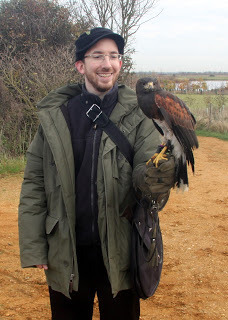 In the new Jewish Action magazine, I have an article about hawking in Judaism. It reveals a fascinating dimension to rabbinic leaders in the period of the Rishonim. You can read it online at this link. Enjoy!
In the new Jewish Action magazine, I have an article about hawking in Judaism. It reveals a fascinating dimension to rabbinic leaders in the period of the Rishonim. You can read it online at this link. Enjoy!
Published on August 12, 2013 09:22
August 7, 2013
Oliphants and Unicorns
As the season of the shofar starts again, I am pleased to announce the release of an updated and expanded edition of my monograph Exotic Shofars: Halachic Considerations. You can download it for free at www.zootorah.com/essays. This latest edition includes a much-improved understanding of the identity of the Biblical re'em, translated as "unicorn" in some Bibles, as well as a discussion of oliphants - horns made out of the tusks of elephants. Please share it with whoever you think may be interested!
For those in LA - I am speaking this Shabbat at YINBH (details will be posted at http://yinbh.ipower.com), and next Shabbat at Sefardic Magen David.
For those in LA - I am speaking this Shabbat at YINBH (details will be posted at http://yinbh.ipower.com), and next Shabbat at Sefardic Magen David.
Published on August 07, 2013 08:18
August 2, 2013
Riverboat Safari
I had planned my tour group to finish with a riverboat safari on the Chobe river in Botswana. It's the most wonderful experience. There are fish eagles, spoonbills, yellow-billed storks, crocodiles, buffalo, impala, waterbuck, and lots of hippopotami:

There are also an enormous number of elephants. Previously, I've seen them swimming in the river; this time, they were just grazing by the river's edge. We stopped just a few yards from where one was deconstructing a tree.
"If that elephant jumps, your career is ruined!" commented one person. (At each meal, as well as during the bus rides, I speak about various animals in the Torah. Last night's topic was the famous/ infamous "jumping elephant" topic.)
We also went on game drives, in which the highlights were a lioness, and one of the most formidable animals in Africa: a honey badger.
There's so much more to tell about the people, places and animals that I saw during my trip, but it's time to get back to Rationalist Judaism, so this is the end of my Africa posts. Right now I am in JFK airport, waiting to fly out to LA, having passed through Botswana, Zambia and South Africa since I got out of bed 34 hours ago! In LA, I'll be speaking at Young Israel of North Beverly Hills, Sephardic Synagogue, and Beth Jacob.
The "Zoo Torah"/ "Torah in Motion" Africa trip was a tremendous success. The trip sold out, and we plan to run it again next summer. If you'd like to join, please write to me.

There are also an enormous number of elephants. Previously, I've seen them swimming in the river; this time, they were just grazing by the river's edge. We stopped just a few yards from where one was deconstructing a tree.
"If that elephant jumps, your career is ruined!" commented one person. (At each meal, as well as during the bus rides, I speak about various animals in the Torah. Last night's topic was the famous/ infamous "jumping elephant" topic.)
We also went on game drives, in which the highlights were a lioness, and one of the most formidable animals in Africa: a honey badger.
There's so much more to tell about the people, places and animals that I saw during my trip, but it's time to get back to Rationalist Judaism, so this is the end of my Africa posts. Right now I am in JFK airport, waiting to fly out to LA, having passed through Botswana, Zambia and South Africa since I got out of bed 34 hours ago! In LA, I'll be speaking at Young Israel of North Beverly Hills, Sephardic Synagogue, and Beth Jacob.
The "Zoo Torah"/ "Torah in Motion" Africa trip was a tremendous success. The trip sold out, and we plan to run it again next summer. If you'd like to join, please write to me.
Published on August 02, 2013 05:39
July 30, 2013
Everyone is Exotic
I have to say, I am very grateful to Hashem for my job. Being the Zoo Rabbi means that I am able to teach in the most incredible settings. Yesterday, my group came to Zambia. We visited Victoria Falls, also known as "The Smoke That Thunders," which was breathtaking. Somehow, a few of us got separated from the rest of the group. Eventually I noticed them on the other side of the ravine, at the extreme right edge of the falls (which are about a mile wide). Look for them in the following picture, somewhere over the the rainbow:

We spent the night at the magnificent Royal Livingstone Hotel, which is right next to the falls. It's a colonial-style hotel, which means that many of the staff wear British shorts and those funny round hats. There are also staff wearing traditional Zambian dress, which consists of berets and gaudy red dresses - for the men!
The hotel is situated on the banks of the Zambezi river. Electrified wire and sharp rocks had been placed between the hotel and the river, to prevent hippopotami from wandering into the hotel grounds and killing people. There was, however, a near-infinite amount of monkeys in the hotel, although they didn't appear to have started work on their Shakespeare scripts. Here's a photo that I took of one of them, which appears to be an albino:

This morning, I woke up before dawn. Hoping to spot some wildlife, I decided to go for a walk. Upon opening the door to my room, I got quite a shock:
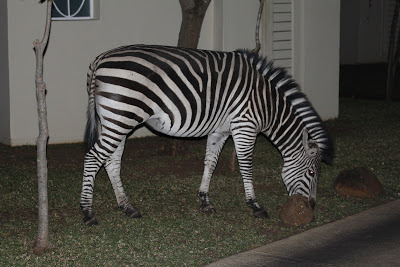
Yup, there was a zebra right outside my room. It didn't seem as surprised to see me as I was to see it.
But the most fascinating experience occurred at shacharis. We made our minyan in our private kosher dining room. The hotel staff, who were setting up breakfast, were absolutely fascinated by our tallesim and tefillin. One of them brought a camera and started shooting pictures of us!
If you're a Zambian man wearing a gaudy red dress, living in the jungle surrounded by monkeys and zebras, then it's Orthodox Jews who look exotic. It was a good lesson in how "normal" is a relative term!

We spent the night at the magnificent Royal Livingstone Hotel, which is right next to the falls. It's a colonial-style hotel, which means that many of the staff wear British shorts and those funny round hats. There are also staff wearing traditional Zambian dress, which consists of berets and gaudy red dresses - for the men!
The hotel is situated on the banks of the Zambezi river. Electrified wire and sharp rocks had been placed between the hotel and the river, to prevent hippopotami from wandering into the hotel grounds and killing people. There was, however, a near-infinite amount of monkeys in the hotel, although they didn't appear to have started work on their Shakespeare scripts. Here's a photo that I took of one of them, which appears to be an albino:

This morning, I woke up before dawn. Hoping to spot some wildlife, I decided to go for a walk. Upon opening the door to my room, I got quite a shock:

Yup, there was a zebra right outside my room. It didn't seem as surprised to see me as I was to see it.
But the most fascinating experience occurred at shacharis. We made our minyan in our private kosher dining room. The hotel staff, who were setting up breakfast, were absolutely fascinated by our tallesim and tefillin. One of them brought a camera and started shooting pictures of us!
If you're a Zambian man wearing a gaudy red dress, living in the jungle surrounded by monkeys and zebras, then it's Orthodox Jews who look exotic. It was a good lesson in how "normal" is a relative term!
Published on July 30, 2013 10:31
July 28, 2013
And We Have A Winner!
There was an astonishingly large response to yesterday's contest. Aside from all the comments on the blog, my inbox was flooded with ideas. Some of them were ingenious! I took the best elements of several of them and combined them for the following:
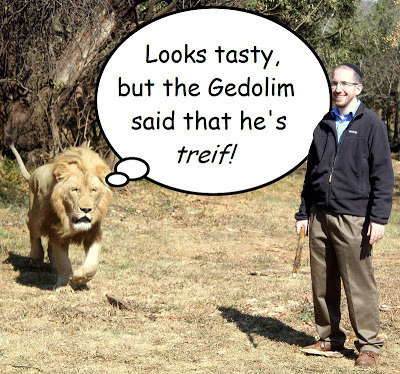
Thanks to everyone for their input!
Right now, it's 4.15am, and I'm heading out to fly to Zambia. I'm not sure how much ability I'll have to post over the next few days. Don't forget that you can subscribe to receive this blog via email, using the subscription form on the right-hand side of this webpage.
Meanwhile, since this Shabbos is parashas Re'ay, I'll leave you with a photo of a nesher that I took yesterday. For more on this identity of the nesher, see this essay.


Thanks to everyone for their input!
Right now, it's 4.15am, and I'm heading out to fly to Zambia. I'm not sure how much ability I'll have to post over the next few days. Don't forget that you can subscribe to receive this blog via email, using the subscription form on the right-hand side of this webpage.
Meanwhile, since this Shabbos is parashas Re'ay, I'll leave you with a photo of a nesher that I took yesterday. For more on this identity of the nesher, see this essay.

Published on July 28, 2013 19:22
July 27, 2013
Incoming!
I'm currently in Cape Town, South Africa, and I wanted to catch up on some things from last week. When I encountered the semi-tame hyena and elephants in a special facility, there was also another animal that I encountered: a five hundred pound lion.
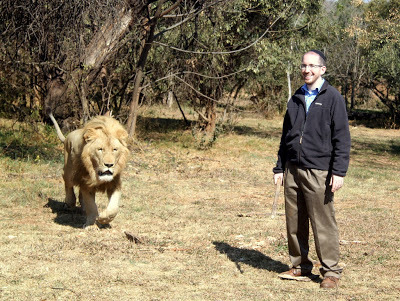
Note that I am holding a short stick. This was to fend him off in case he attacked me. Seriously. As the animal handler told me, there's no such thing as a tame lion.
I'll write more about this extraordinary experience and post more pictures/ video on another occasion. Meanwhile, I thought that it would be fun to have a contest. Please suggest what you think would be amusing to portray the lion as thinking when he approached me:
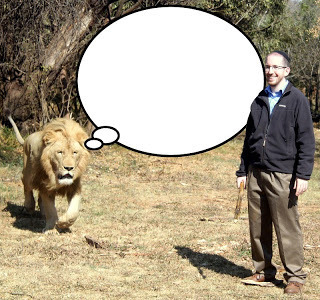
My own idea, based on a famous statement by Reuven Schmeltzer, is "I'm a shaliach from Rav Moshe Shapiro, being lochem milchemes Hashem!" But perhaps you can come up with something funnier.

Note that I am holding a short stick. This was to fend him off in case he attacked me. Seriously. As the animal handler told me, there's no such thing as a tame lion.
I'll write more about this extraordinary experience and post more pictures/ video on another occasion. Meanwhile, I thought that it would be fun to have a contest. Please suggest what you think would be amusing to portray the lion as thinking when he approached me:

My own idea, based on a famous statement by Reuven Schmeltzer, is "I'm a shaliach from Rav Moshe Shapiro, being lochem milchemes Hashem!" But perhaps you can come up with something funnier.
Published on July 27, 2013 14:04
July 24, 2013
With Moses in the Wilderness
Here in Africa, many African-Americans - sorry, I mean African-Africans - have interesting names. On yesterday's game drive, the driver, before setting off, launched into a long introduction. He spoke with the slow manner of speaking that some Africans use, in which they draw out each syllable in a painfully long amount of time. "Myyyyyy naaaaame," he said slowly, "is Civilized. C - i - v - i - l - i - z - e - d. I am your driiiiii-veeerrrrr for todaaaaaaaaaaaaaaaaay."
"Hi, Mr. Civilized," I said, "My name is Impatient. Can we get going?"
On this morning's game drive, the driver was called Moses. He led us through the wilderness, starting before dawn. We didn't see as many species as yesterday, but we did have the rare thrill of being in the midst of a huge buffalo herd, seeing a herd of elephants, and watching a leopard and her cub roaming around. The cub kept on launching surprise attacks at the mother, which she tolerated as only a mother can. Here's a picture that I took of the cub:

We watched them for quite a while, then headed off to meet up with the other jeeps, in order to make a minyan for shacharis out in the savannah. Meanwhile, two people on my jeep were quite desperate to go to, er, attend to a call of nature. But Moses didn't want to stop, because he was in a rush to meet up with the other jeeps. "Moses!" I thundered, "Let my people go!"
Later, back at the ranch, I took the following photograph of an impala at the water-hole by the dining room, which brought a certain passuk to mind:
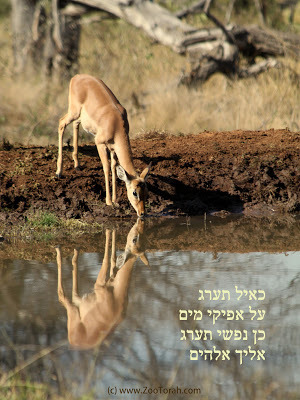
And finally, here's a video clip of the leopards:
"Hi, Mr. Civilized," I said, "My name is Impatient. Can we get going?"
On this morning's game drive, the driver was called Moses. He led us through the wilderness, starting before dawn. We didn't see as many species as yesterday, but we did have the rare thrill of being in the midst of a huge buffalo herd, seeing a herd of elephants, and watching a leopard and her cub roaming around. The cub kept on launching surprise attacks at the mother, which she tolerated as only a mother can. Here's a picture that I took of the cub:

We watched them for quite a while, then headed off to meet up with the other jeeps, in order to make a minyan for shacharis out in the savannah. Meanwhile, two people on my jeep were quite desperate to go to, er, attend to a call of nature. But Moses didn't want to stop, because he was in a rush to meet up with the other jeeps. "Moses!" I thundered, "Let my people go!"
Later, back at the ranch, I took the following photograph of an impala at the water-hole by the dining room, which brought a certain passuk to mind:

And finally, here's a video clip of the leopards:
Published on July 24, 2013 10:15
July 23, 2013
Kings Camp
Today, I flew out with my group to the Timbavati game reserve. Most of my group is staying in the spectacular Kings Camp lodge, which consists of eleven cabins, along with the dining room, etc. I was slightly surprised to see on the reservations list that I had been placed in a room together with Rabbi Yoni Isaacson, the tour operator. But I figured that since we are both here without our wives, it would be cheaper to house us both in the same cabin.
Upon entering my cabin, I was in awe of the decor - see the picture below. I was simultaneously horrified to discover that it was the honeymoon suite - with a king-size bed, and a bath that had already been filled with hot water and bubbles and candles placed around it, with a sign next to it saying "Natan and Yoni - Rejoice!"

To my immense relief, R. Yoni informed me that he would be sleeping elsewhere.
In the evening, we headed out on our first game drive. I've been on numerous game drives before, but this one was my best yet. We saw impala, steenbok (not the steenbok mentioned by Rashi in Chullin, which is an ibex, but rather a type of tiny antelope), nyala, buffalo, wildebeest, giraffe, vervet monkeys, baboons, civet, genet, warthog, hare, elephant, hornbills, vulture, zebra, leopard, and lion! Here are pictures that I took of buffalo, vulture, and lion:



As I told my group, if you want to see the animals of the Torah today, Africa is the place to see many of them!
(It's also amazing to be writing this post on a wi-fi connection in the middle of the African wilderness!)
Published on July 23, 2013 11:59

